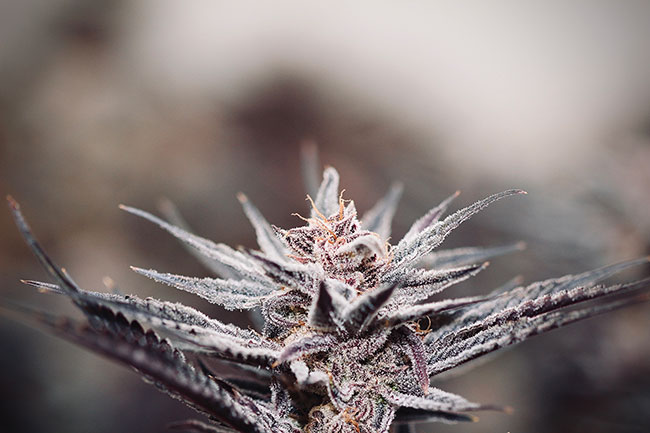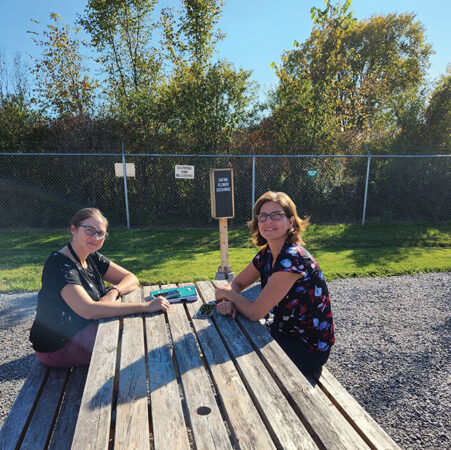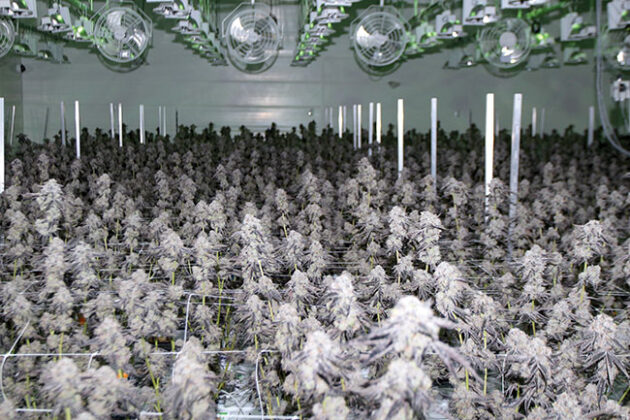
Features
Cultivation
Management
Production
Research
Cover Story: The science behind Safari
Safari Flower is home to Niagara’s poster girl master grower Stacie Hollingworth, and cannabis testing and quality assurance mogul, CEO Brigitte Simons
April 5, 2023 By Haley Nagasaki
 Touring nine aromatic flower rooms at Safari Flower Co. revealed this close up of a plant nearing harvest.
Photos: Safari Flower Company
Touring nine aromatic flower rooms at Safari Flower Co. revealed this close up of a plant nearing harvest.
Photos: Safari Flower Company The Niagara region of southern Ontario, renowned for agricultural excellence and wine production, has developed a distinct craft cannabis presence suggestive of national and international expansion, as well as an attractive hotspot for cannabis tourism.
Safari Flower Company lies a 20-minute drive from the Niagara core in Fort Erie. In this Ontario agricultural heartland, an award-winning team helms Safari, including Niagara born and raised agriculturalist and master grower Stacie Hollingworth, and CEO Dr. Brigitte Simons, who received her PhD in analytical chemistry.
Simons’ long-standing background in testing and quality assurance is upheld by her position as director on the C-45 Quality Association board, bringing a skillset that spans numerous disciplines and provides multiple business opportunities to Safari Flower, including the implementation of an in-house tissue culture laboratory led by Dr. Adel Zarei. The laboratory offers rare scientific transferability to the commercial scale of production by providing tissue culture and pathogen indexing services to the industry.
“Over time, the rigor of genetics holding a specific cannabinoid content may deteriorate and attract diseases through commercial handling – we then clean up the genetics and sell pathogen-free mother stock back to producers,” says Simons.
Simons’ inspiration for the international trade of Safari’s intellectual property, backed by Hollingworth’s data-driven indoor growing methods, is an intended business transparency that translates to desirable products sold in premium categories, including the latest brands – Sunset Octane, El Fuego, and WiFire – in collaboration with Garden City Cannabis Co.
Safari’s talent
The predominantly female management team at Safari Flower Co. has been (though the volume of female applicants) noted, while the number of women appointed to executive level cannabis remains relatively low. Simons says Safari has lucked out in attracting top talent that happens to be female.
Stacie Hollingworth’s diverse grow portfolio and love of cannabis as a medicine represents her methodical journey from legacy to commercial craft at-scale growing.
As a graduate from Niagara College’s commercial cannabis program, she understands cannabis culture from a greenhouse application, from scholarly studies, and experiences from the legacy market of understanding how quality sells. Furthermore, Hollingworth analyzes room environmentals and plant health traits within their state-of-the-art indoor facility. This helps her translate data to commercial scale crops of flower, yielding 6,800 kg of dried product per year. The 120 kg per crop scale produced every week is why the team sets their sights on international distribution.
As poster girl for Niagara’s agricultural scene, last year Hollingworth won Master Grower of the Year at Grow Up’s annual industry awards ceremony, and her position on Grow Opportunity’s 2022 Top Grower Award judging panel indicates further industry recognition of her intellectual property.
The Safari team’s scientific accolades are unique for this industry. As mentioned, Simons holds her PhD in analytical chemistry, while Zarei is a PhD scholar in plant molecular biology. Together, with a lab technician team, the business publishes scientific literature that advances the fields of plant tissue culture and disease remediation.
“Legacy market genetics are highly desirable and their entrance into legal cultivation is something I witnessed working on the West Coast in 2019 where I assisted illicit micro-cultivators’ transition,” says Simons. “However, establishing these legacy genetics at 1,600 plant crop-scale exacerbates any in-born disease, if present, and really places financial risks once the business sinks working capital costs to produce.”
Zarei’s micro-propagation research enables Safari’s genetics stability for commercial applications as nursery acquired clones lead to inconsistent health.
Safari supports a crew of 35 in cultivation, another 40 in processing, and eight people in management. Their 10 carbon copy rooms, nine of which are dedicated to flower production, enables weekly or bi-weekly harvest, yielding 100-120 kg of dried craft flower per room. On top of their own SKUs, they provide the bulk flower to a number of other Canadian brands.
Safari focuses on the commercialization of forward-thinking consumer tastes in collaboration with store-brands and SKUs that meet the formats they sell in the region. Safari also wholesales flower to another 23 premium Canadian brands.

Master grower Stacie Hollingworth and CEO Brigitte Simons sit on site. Photo: Safari Flower Company
Winning methodology
Touring Safari Flower reveals one room dedicated to mothering, vegging, and cloning, while the other nine are flower rooms. These identical rooms have an approximate 200-meter square canopy allowing Safari to grow craft at scale.
The Niagara LP grows in one-gallon coco, with a tailored fertigation recipe, in rooms each the size of a micro-cultivator. Safari’s core team gauges their fertilizer by testing nutrients and performing in-house leaf analysis.
“Data collection is key.” Once the fertilizer formula is dialed, using an advanced auto-dosing system, Hollingworth continues a hands-off approach where cultivators will defoliate three or four times throughout the life cycle, in addition to some scouting and in-process lab testing.
“We’ve gone through quite a few ups and downs with disease. Especially when we first started, we were complete contract growers,” Hollingworth says.
The company would take on genetics from other LPs, receiving some 2,000 clones from other producers for the Safari team to grow out. This proved to be a detrimental practice for bringing in pests and pathogens, though now that they’ve further self-regulated, the company’s been pest and disease free for about one year.
Currently, Safari keeps five or six different cultivars growing, bringing in new varieties all the time for trial. Hollingworth calls their cultivar on-boarding scenario as “stress-testing before production scale,” meaning not all cultivars will thrive beneath their conditions and must first be trialed and assessed for commercial viability.
“You want us to grow your Blue Dream for you but first we need to see how it grows in our facility,” she says. This process takes six or eight months to discern.
Right now, Hollingworth is partial to the 8-Ball x Octane OG Kush and says it’s rewarding to grow. Another favourite cultivar is sativa dominant Dark Shadow Haze. Safari uses a cyclical pattern to revisit each cultivar that does well beneath their cultivation methods and in market response.
“The economic trend is this demand for new cultivars every product drop,” says Simons. “It’s the demand on the Canadian economy to have something new, something high, and something ready to fill scale.” This means that whether a producer has product ready, they must be prepared. The adaptability accompanying these targets entails the constant preparation of new cultivars meeting consumers tastes and yielding a potent chemical target with the right terpene profile.

One of nine carbon copy flower rooms in full bloom at Safari Flower Co. Photo: Safari Flower Company
Addressing market concerns
Every product launch needs something catchy that holds bag appeal and can retain the premium price points for 3.5-gram containers.
Meeting the THC levels demanded by the market is getting harder and harder, especially when high THC does not necessarily correlate to quality practice – a fact that is lost when product gating happens between government and retail.
The reason for this, Simons explains, comes as a result of data. “They see pre-rolls at 27 per cent total THC moving faster than a very nice light flower at say 18 per cent, which is something I actually want to buy but I don’t have variety anymore.”
Hollingworth said she doesn’t know of anyone actively seeking out 27 per cent. Consumers in retail might ask for a store’s highest, but they wouldn’t necessarily know the difference between total THC labeled as 22, 25, or 27.
“For a grower like us, we know that our genetic library has high value beyond pressing over 28 per cent total THC and de-tuning all the other terrific chemical attributes of the plant,” says Simons.
Regardless of the hurdles, this far-reaching company, with its many avenues and talents, has adapted to the needs of the Canadian consumer and international purchaser.
Nestled in a locale historically attractive to international tourism markets, at a time when farmgate gains momentum and budtenders and educators tour local indoor growing facilities – experiencing sight, taste, and smell firsthand – there’s no cap on the long term potential of a producer like Safari Flower.
Print this page